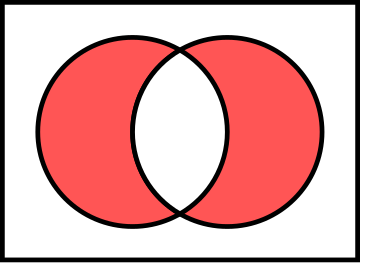Reputation: 58522
SQL Server Difference (opposite of intersect)
Looking for the easist/most scalable way to do a set "difference" in SQL Server see below.

If you can't tell from the picture i am looking for everything that is not in the intersection.
I have seen one way to do it:
select * from (
(select 'test1' as a, 1 as b)
union all
(select 'test2' as a , 2 as b union all select 'test1' as a , 1 as b )
)un group by a,b having count(1)=1
But i fear what would happen if i used two large sets (i will not be querying from select '' constant statements, my queries will be pulling from real tables.)
EDIT:
Possible solution...
drop table #temp_a;
drop table #temp_b;
go
select * into #temp_a from (
select 1 as num, 'String' as two, 'int'as three, 'purple' as four union all
select 2 as num, 'dog' as two, 'int'as three, 'purple' as four union all
select 3 as num, 'dog' as two, 'int'as three, 'cat' as four ) a
select * into #temp_b from (
select 1 as num, 'String' as two, 'decimal'as three, 'purple' as four union all
select 2 as num, 'dog' as two, 'int'as three, 'purple' as four union all
select 3 as num, 'dog' as two, 'int'as three, 'dog' as four ) b
SELECT IsNull(a.num, b.num) A,IsNull(a.two, b.two) B, IsNull(a.three, b.three) C,
IsNull(a.four, b.four) D
FROM #temp_a a
FULL OUTER JOIN #temp_b b ON (a.num=b.num AND a.two=b.two and a.three=b.three and a.four=b.four)
WHERE (a.num is null or b.num is null )
RESULTS:
1 String int purple
3 dog int cat
1 String dec purple
3 dog int dog
Upvotes: 24
Views: 32363
Answers (3)
Reputation: 1499
Alternative:
SELECT A, B FROM Table1 UNION SELECT A,B FROM Table2
EXCEPT
SELECT A, B FROM Table2 INTERSECT SELECT A,B FROM Table1
Upvotes: 16
Reputation: 34909
How about something like this?
SELECT A, B FROM Table1 EXCEPT SELECT A,B FROM Table2
UNION
SELECT A, B FROM Table2 EXCEPT SELECT A,B FROM Table1
Here is an example with the FULL OUTER JOIN method (assuming A is not nullable in both tables)
SELECT IsNull(Table1.A, Table2.A) a,IsNull(Table1.B, Table2.B) B
FROM Table1
FULL OUTER JOIN Table2 ON (Table1.A=Table2.A AND Table1.B=Table2.B)
WHERE Table1.A is null or Table2.A is null
Upvotes: 28
Reputation: 332541
What you're after is called a Full Outer Join, which SQL Server supports.
Upvotes: 4
Related Questions
- What's different between INTERSECT and JOIN?
- SQL Server Intersection of Records from Single Table
- T-SQL difference between WHERE EXISTS and INTERSECT
- Transact SQL using EXCEPT vs INTERSECT
- Intersect in SQL Server
- Correct way to use SQL Intersect
- Using conditional operations in conjuction with INTERSECT in SQL Server
- SQL in-line equivalent to intersect
- SQL Query that can return intersecting data
- TSQL INTERSECT Keyword